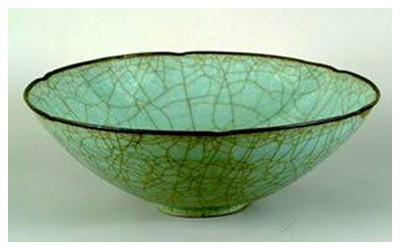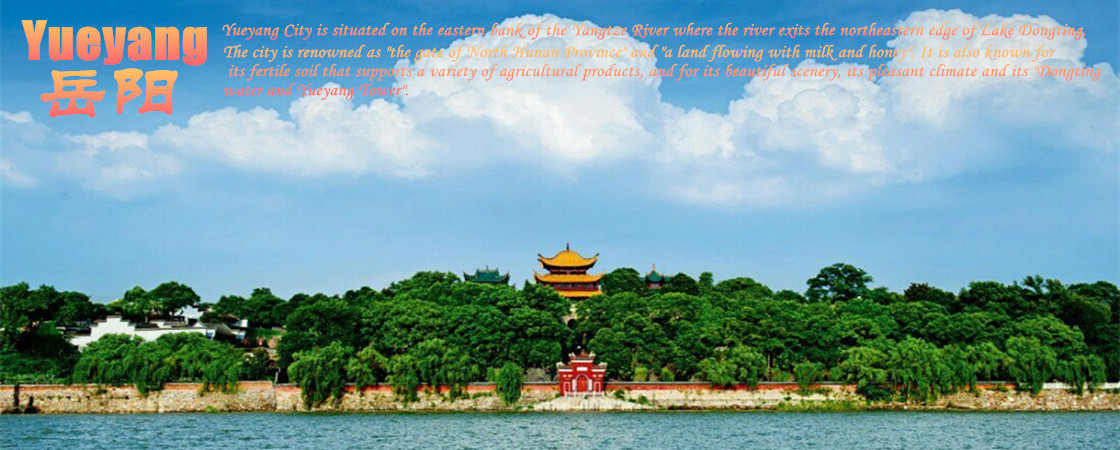
Yuezhou Kiln is located near the dyke of Chengguan Town in
Xiangyin County, within the 700-meter-long area from Shuimen in the north to Dongting Temple site in the south.
Xiangyin was under the administration of Yuezhou in the old days, hence the name of the kiln. A folk saying goes that: "Xiangyin possesses thousands of kilns which were even earlier than the county itself".The site of Xiangyin kiln was found in 1952, and some old kilns were founded in
Yaotou Mountain and Liyuan in 1972. Archaeologist excavated the sites and found lots of celadon wares and kiln furnitures which could be traced back to the Han Dynasty (202 BC - 220 AD) and Three Kingdom Period (220-280 AD).
In the Five Dynasties (907-960 AD), the porcelain body adopted in Yuezhou kiln was thin and light, not as dense as that of the Yue kiln. The body color tended to be red or beige and became gray in the later period. The glaze was almost turquoise and green-yellow. The thin and smooth glaze with tiny glaze bubbles made the porcelain touched like glass. The surface was decorated with tiny irregular ice cracks and sometimes trails of flowing glaze.
The wares of Yuezhou kiln include bowls, plates, bottles, high-foot plates, and eight-handle pots (four pairs of facing handles). The bases of bowls are mainly round and the high-foot plats and eight-handle pots are distinctive.
A celadon-glazed dragon head vessel was unearthed in Xiangyin County in 1973, which can be traced back to the Sui Dynasty (581-619 AD). The body is grey, covered with celadon glaze. The spout and handles are respectively shaped into dragon head and tails. The whole vessel is in a round-ball shape, with three high feet supporting it stably. This dragon head vessel is rather a masterwork of the Yuezhou kiln, imitating the metal vessel of the pre-Qin period (21th century BC-221 BC). It is currently collected in Hunan Provincial Museum presently.
Yuezhou kiln played a significant role in China's porcelain history, inheriting Yue kiln in Jiangsu and Zhejiang area and inspiring Tongguan kiln in
Changsha. Most porcelain wares for civil use in central
China at that time were produced here, which has been approved by the unearthed objects.

 Yuezhou Kiln is located near the dyke of Chengguan Town in Xiangyin County, within the 700-meter-long area from Shuimen in the north to Dongting Temple site in the south. Xiangyin was under the administration of Yuezhou in the old days, hence the name of the kiln. A folk saying goes that: "Xiangyin possesses thousands of kilns which were even earlier than the county itself".The site of Xiangyin kiln was found in 1952, and some old kilns were founded in Yaotou Mountain and Liyuan in 1972. Archaeologist excavated the sites and found lots of celadon wares and kiln furnitures which could be traced back to the Han Dynasty (202 BC - 220 AD) and Three Kingdom Period (220-280 AD).
Yuezhou Kiln is located near the dyke of Chengguan Town in Xiangyin County, within the 700-meter-long area from Shuimen in the north to Dongting Temple site in the south. Xiangyin was under the administration of Yuezhou in the old days, hence the name of the kiln. A folk saying goes that: "Xiangyin possesses thousands of kilns which were even earlier than the county itself".The site of Xiangyin kiln was found in 1952, and some old kilns were founded in Yaotou Mountain and Liyuan in 1972. Archaeologist excavated the sites and found lots of celadon wares and kiln furnitures which could be traced back to the Han Dynasty (202 BC - 220 AD) and Three Kingdom Period (220-280 AD).  Ask Questions ?
Ask Questions ?